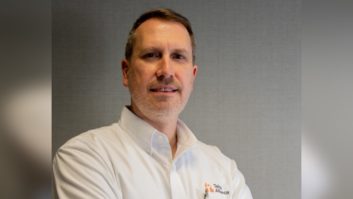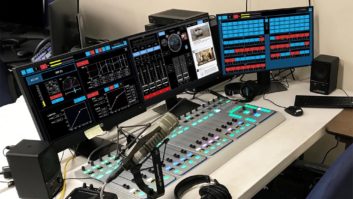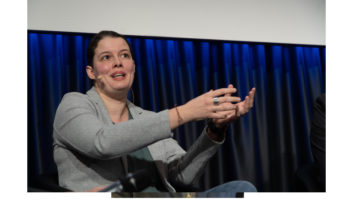Sharing production resources
Sep 1, 2000 12:00 PM, Jim Cook
One incongruity in the post-consolidation radio community is that demands and expectations have increased, but budgets have decreased. The focus on real-time, in-market delivery of product suddenly tilted. We have spent the last 80 years in radio putting our technical eggs into the on-air studio basket while the production room was treated as the ugly stepchild.
In just a few years, we have begun exporting talent, centralizing production and shifting the focus from air to production studios. This raises the question of where this additional production talent was found. The answer is, we didn’t find any at all.
To fulfill the demands of post-consolidation radio, it has become apparent that we need to maximize the time and resources of the producers who deliver quality product, centralize the production process, and implement enterprise-wide systems that aid the mandate.
Although we have come a long way, the game has just begun. Given the intramarket differences in equipment, connectivity and human resources, the task is complex at best. The Clear Channel stations in Atlanta provide one example.
Within the building are nine production rooms. Each room is networked so that a session in one studio can be called up in any room. Using Novell networking, a network folder is assigned to each room. You can log onto the network as studio A while in studio B. This flexibility allows for studio use to be maximized and prevents the “I-need-to-get-in-here” syndrome from shutting down production.
Atlanta exists as one of several hub markets for Clear Channel. The Peachtree Road studios currently house four FM, one AM, one statewide news network, and one nationally syndicated talk show. From this location, we also export air talent voice-tracked shows, create, log and air commercial production for spoke stations, and create, network and share station image production with other Clear Channel stations nationwide.
This is accomplished through one of several methods of network connections.
Method one A power producer creates a Rush Limbaugh promo for the Atlanta news/talk station WGST. The multitrack promo is then exported using DAW software, in this case an Orban Audicy. This allows the entire session to be bundled into a single file. The file (with a .prd extension) is uploaded to an FTP site via a T1. Other news/talk stations using Audicy networking can download and import the file directly into their editors.
Once the file is reconstituted at the local station, the producer deletes the Atlanta references and any licensed material and reconstructs a custom local promo. This allows the power producer to finish the job after the upload. No additional customization is required. The producer’s time has been used efficiently.
Method two A station morning show promo is produced on a multitrack DAW. The power producer or secondary producer then strips the promo to a shell, leaving out all local references and licensed material.
The original sound file and the stripped shell are then recorded into a single MPEG file that can be sent via e-mail to a specific market or producers, or can be uploaded to a central storage server (which in our case is called the Clear Channel Noise site).
The Noise site is available on the Clear Channel intranet. It is arranged so the best promos are available to anyone with access to the WAN. A simple follow-the-prompt button and links allow for file uploads and downloads. Each file has a listen button that allows program directors to preview any promo. Once a file is chosen and downloaded, the finished example (with references to the market in which it was created) is removed and the two-track shell is loaded into any multitrack editor and customized at the local level.
Also attached to each entry is a comments section that provides complete production details for the local producer.
We have been able to use Noise as a searchable database. We continually upload movie and TV drops, generic winners, news sound bytes, national contest work parts, and talent air-checks. In this way, our most versatile and talented producers are shared across the enterprise.
More examples A series of promos, teases and sweepers for a groupwide contest is created in Atlanta for AC station Peach 94.9. These elements are stripped of local references and loaded into the digital delivery system. Most Clear Channel stations use the same system (Prophet Systems) and can access the file at Peach 94.9 through the WAN to Atlanta. The audio is sent via data packet to each market on demand at the click of a button.
In cases where two markets are not using the same DAW (Audicy and ProTools, for example), all of the audio is saved to eight tracks in four stereo pairs. The four stereo pairs are saved as MPEG or WAVE files and uploaded and downloaded via any of the above methods. These audio pairs can be saved into any multitrack that accepts the file format and reconstituted as a complete tracked session. In a few cases, the discrete files must be manually aligned. This is done by placing an audio signal (which we call a two-pop) at the beginning of each audio pair. The two-pop sync tone is then lined up on each track pair in any digital editor.
A recent national contest required that a Cincinnati-created production was available for playback within a few hours at all participating markets. This was accomplished by having the power producer in Cincinnati feed the finished session via ISDN to the Premier Network head-end uplink in Los Angeles. The session was then replayed minutes later (sometimes while editing was still in progress) over the satellite and all the stations could receive the feed for playback.
As consolidation forces us to raise the bar in the creative arena, it has increased the demands in the technical forum. The objective is to redesign the production department and to rethink the single station “market island” idea, a concept we have lived with from the dawn of commercial radio. The future lies in minimizing technical variables, increasing training and maximizing time management for the power producer. That’s the funny thing about post-consolidation; it has forced us to refocus, rethink, reorganize and, I’m sure we all hope, improve the creative matrix.












